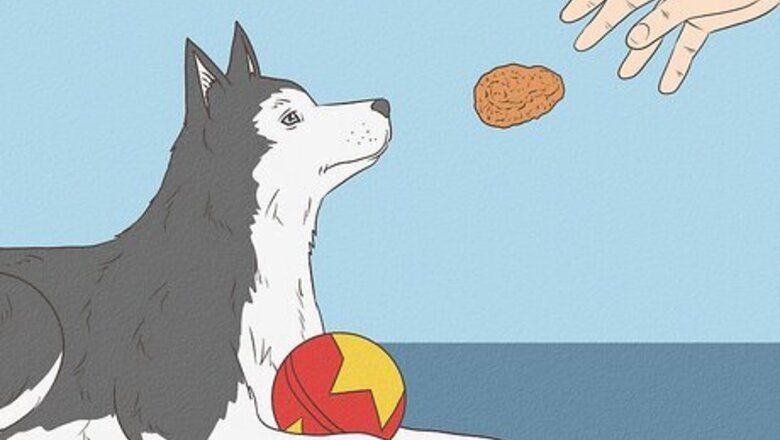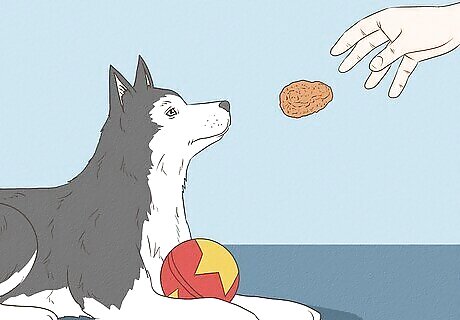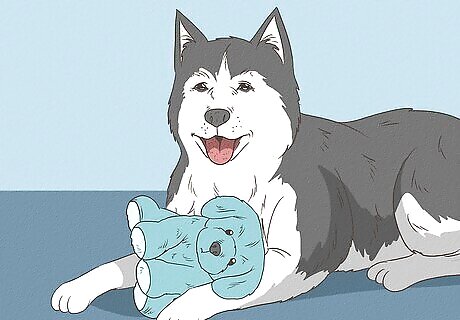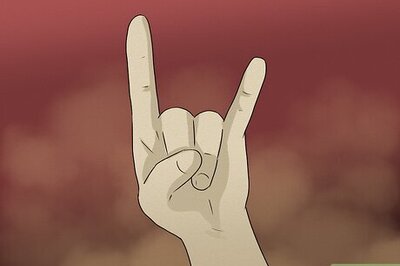
views
- Toss your dog a high-value treat (like a hot dog) every time they have something they guard. Approach at a safe distance, toss the treat, then turn and leave.
- Teach them to “drop” what they’re holding by giving them a low-value toy and placing a treat under their nose. When they drop the toy, give them the treat.
- If your dog is hyper-possessive over a specific toy or item, remove it from the house or put it somewhere your dog can’t get to it.
Training Your Dog to Stop Resource Guarding

Toss your dog a high-value treat any time they have an item to guard. A high-value treat is anything that your dog loves more than whatever they’re guarding, like a treat, a piece of chicken, or a hot dog. Approach your dog a short distance from when they start to react. Toss the treat to them, and when they eat it, toss another. Then, turn and leave. If you have multiple dogs, put them in separate rooms so you can train the dog who’s resource guarding one-on-one. Optionally, say something like “What have you got there?” in a conversational tone as you toss the treat. After a few sessions, begin to add one more step towards them before tossing the treat, and then step back. If your dog gets tense, take the training back a step. This can let your dog know that they should expect good things when you approach them. When their body language becomes more relaxed, that means the training is working.

Teach your dog to “drop it” by offering a high-value treat. To teach your dog to “drop it,” offer your dog a low-value toy, let them play with it, and then put a high-value treat under their nose. As soon as your dog drops the toy, praise your dog or use a clicker, then give them the treat. Pick up the toy and hold it behind your back, then repeat the process. When you know your dog will drop the item after you show the treat, add a verbal cue like “drop it.” This training can teach your dog that giving up something they’re possessive over can be a good thing. If you need to take an item away from your dog, use the verbal cue and offer your dog a trade with something higher value than the item, like chicken or a special treat.

Give your dog high-value treats in exchange for low-value items. Give your dog a low-value dog toy and allow them to play for a while. Offer them a few high-value treats, and as they’re eating, remove the low-value item. Repeat a few times until your dog is excited when you approach. Then, try to trade the item for the treat simultaneously. Practice this technique with a variety of items your dog doesn’t show interest in guarding, then slowly move up to more valuable items. You may start with a toy they don’t play with, then move to a toy they sometimes play with, then a favorite toy, and then a toy they absolutely love. If your dog shows interest when you take away the low-value item, try making a trail of treats leading away from the item so you can pick it up. Tethering your dog to a door or piece of furniture with a leash before training can create a way for you to move away from them if they start growling, freezing up, or snapping. Practicing trading with your dog can help them feel better about having their stuff taken away, which may help reduce or eliminate your dog’s guarding behavior.

Consistently reward your dog for good behavior. Work on building your dog’s confidence by exposing them to new people, situations, and animals. When they have positive interactions and don’t guard against other people or animals, reward them immediately afterward with a treat. Consistency is key—make sure everyone in the household knows to reward your dog when they interact positively with other people and animals in different situations. If you have 2 dogs that fight over a spot in the living room, assign them both a different spot and train them to lie there on cue, rewarding each successful sit with a treat. If they go to the wrong spot, they don’t get a treat.
Preventing Resource Guarding From Escalating

Try to avoid punishing your dog for resource guarding. It can be surprising or even frightening when your dog growls or tenses up. However, punishing a dog for resource guarding can make them more aggressive because their worst fears have been verified. If your dog growls or tenses up, take a step back and try the above training methods instead. If your dog growls at you and you yell at them, for example, they might be more likely to skip the growl and go straight for a bite. If your dog growls, it’s their way of trying to tell you to “back off” without escalating to a bite.

Provide enough resources for all animals in your home. Make sure you have enough toys, beds, crates, treats, and food to go around. If you adopt a second dog and buy them a brand new fluffy bed, your first dog may want that one instead of their old one. To avoid trouble, you may want to buy them a new one, too. If your dog food guards against people, ask others to not go near your dog while they’re eating. If your dog guards their food against other dogs, try sequestering them in their own rooms during mealtimes.

Remove any items that a dog is overly possessive of from the situation. If your dog is possessive when it comes to a specific toy or item, remove the item from the house entirely. If a new dog visits your space, try to create a neutral environment free of items that may cause tension, like toys, crates, or food. If your dog loves to take your shoes from the closet but growls when you try to take them away, put them where your dog can’t reach them. If your dog does get an item you need to get away from them, distract them with treats far enough away from the item that you can retrieve it safely.
When to Seek a Professional for Resource Guarding

Seek a certified dog trainer if your dog’s behavior hasn’t changed. If you’ve tried all the preventative and training methods above and your dog’s behavior hasn’t changed, it may be time to find a trainer or behaviorist. Your veterinarian can recommend one for you. Some dogs may start resource guarding another item or person after you train them not to guard the original item, which can be a sign to seek out a professional for help. If you’re worried your dog might bite someone, that’s also a good sign you need to call in the experts.
Why does resource guarding happen?

Resource guarding is a normal and natural dog behavior. The reason behind resource guarding varies, but it’s typically based on a worry that what they love will be taken away. Although the behavior often occurs with adult dogs, puppies might resource guard as they learn to navigate the world. Other contributing factors might include: Genetics: A dog’s breed or mix might have predispositions for guarding behavior. Stress: When a dog is stressed because of guests in the home, new family members, or stress-inducing events like fireworks, their guarding behavior might increase. The item’s inherent value: Food often has the highest value, but every dog is different in what they see as inherently valuable. Other needs not being met: This could be a long-term issue, like lack of enrichment or exercise, or a short-term issue, like tiredness, hunger, or thirst. Underlying medical issues: Pain can increase the frequency or intensity of aggressive behavior. If guarding is a new behavior, visit a veterinarian for a health check up. Training: In an attempt to assert dominance, some owners might take a puppy’s food or toy away. This only teaches the dog that a human approaching means the item will disappear, and may cause them to respond defensively. History of resource scarcity: Former street dogs or dogs from environments with fewer resources might still feel the drive to protect what they have. However, one study found that food aggression is not linked to a history of food scarcity.
Recognizing Resource Guarding

When a dog resource guards, they may growl or become tense. Resource guarding can escalate to more aggressive behavior, like biting, so it’s important to watch for signs so you can learn what your dog is anxious about and intervene if needed. Signs of resource guarding include: Raised lips and bared teeth Growling Lunging or air-snapping Chasing you or another animal away Lip-licking Ears pointed backward Stiff, raised tail as you approach Sudden and obvious pauses or tension in the body Braced body position over the item Subtle shifting of body to “block” the item Hard or side-eye staring Eating faster (if food is the resource they’re guarding) Increased attentiveness to other dogs


















Comments
0 comment